62 - Pagan Night
Friday, June 28, 2013
.JPG) Magic was most definitely in the air as the fates conspired in the best possible way, and not only put La Noche de San Juan on a Sunday but also ensured it coincided with a super-moon – the biggest and brightest full moon of the year, closer than usual, and causing lower low-tides and higher high-tides. Coming so close on the heels of the solstice just two days before meant it was lower down than usual, creating a huge orangey-red orb on the sea’s horizon. Magic was most definitely in the air as the fates conspired in the best possible way, and not only put La Noche de San Juan on a Sunday but also ensured it coincided with a super-moon – the biggest and brightest full moon of the year, closer than usual, and causing lower low-tides and higher high-tides. Coming so close on the heels of the solstice just two days before meant it was lower down than usual, creating a huge orangey-red orb on the sea’s horizon.
.JPG)
All of which combined to bring what seemed like the entire population of Spain onto the beaches on Sunday night. Presumably somewhere way back there’s some religious relevance to this festival (it is, after all, the Night of St John the Baptist), but what was on clear display was a traditional coming-together to enjoy the beach, share a barbecue with friends and family, and take part alongside thousands of others in a string of pagan rituals.
Of .JPG) course it all began with the lighting of fires – Las Hogueras de San Juan (Los Fogueres de Sant Joan in Catalunya). On the Malagueta beach in Málaga city there was barely a towel space to be had, and smoke spiraled upwards in the still air. Around 10pm most fires were functional, cooking food, and keeping warm the brave swimmers who had been in and out of thesea all evening. Food shared and consumed, the fires became less tidy and were merged with those nearby to create bigger bonfires, now stoked with planks and old broken furniture saved for tonight. course it all began with the lighting of fires – Las Hogueras de San Juan (Los Fogueres de Sant Joan in Catalunya). On the Malagueta beach in Málaga city there was barely a towel space to be had, and smoke spiraled upwards in the still air. Around 10pm most fires were functional, cooking food, and keeping warm the brave swimmers who had been in and out of thesea all evening. Food shared and consumed, the fires became less tidy and were merged with those nearby to create bigger bonfires, now stoked with planks and old broken furniture saved for tonight.
.JPG)
As midnight approached, all of a sudden the sky above Málaga was filled with flaming lanterns, hovering way above us, and visible many kilometres away in Nerja.
.JPG)
On the stroke of midnight there was a surge towards the sea. Whether naked, in bikinis or shorts, or fully-dressed, almost everyone went in at least ankle-deep. Particular care was taken to wash the feet properly, cleansing us of sin, and guaranteeing good luck for the coming year.
A few older couples, or groups of women, were perhaps casting back to a time when San Juan was celebrated in a more reverent fashion. Sitting quietly on a blanket, they sheltered their lit candles from the merrymakers. Not disapproving, and not separate, they brought to the evening their own thoughts – and probably their prayers, which throughout the rest of this night of revelry were largely absent.
Some of the lads, fuelled more by San Miguel than San Juan, jumped three times over their bonfires, further ensuring their sins were fully cleansed (or, more likely, ensuring that the girls were impressed!).
Bonfires ….. sharing food ….. a full moon ….. the shortest night of the year ….. a mass washing of the feet …. lanterns sacrificed to the moon and the wind. In many northern hemisphere countries this is the night that represents change. The fire purifies, destroys, and the phoenix rises again from the ashes to recreate. The water recuperates, refreshes, and rejuvenates. Myths tell us that pagan gods appear on the shortest night, and inexplicable things occur.
 Back in the UK a similarly bizarre ritual occurred two nights before. The Filly Loo, in the tiny Dorset hamlet of Ashmore near my home town of Shaftesbury, is the kind of festival that would confirm many people’s worst fears about “The West Country” and if somebody’s sat-nav accidentally took them through the village on that night it could give them nightmares for many a year. The flaming torches, the village pond, and the bonfire create obvious parallels to the San Juan festival …. and the Filly Loo’s antler men, the Green Man, and mournful music share the pagan roots demonstrated on San Juan. Back in the UK a similarly bizarre ritual occurred two nights before. The Filly Loo, in the tiny Dorset hamlet of Ashmore near my home town of Shaftesbury, is the kind of festival that would confirm many people’s worst fears about “The West Country” and if somebody’s sat-nav accidentally took them through the village on that night it could give them nightmares for many a year. The flaming torches, the village pond, and the bonfire create obvious parallels to the San Juan festival …. and the Filly Loo’s antler men, the Green Man, and mournful music share the pagan roots demonstrated on San Juan.
These crucial dates in the calendar, the changes of seasons, the coming of new life, bring disparate parts of the world together in innate and instinctive ways, sharing a reverence for nature and the rich cycle of our year.
And if none of that, well, it’s a great excuse for a barbie on the beach!
© Tamara Essex 2013
THIS WEEK’S LANGUAGE POINT:
Volver – to return. Buying a return train ticket – ida y vuelta. But used much more frequently about “doing something again”. Ha vuelto a escribir de nuevo. He/she has started to write again. Hemos vuelto a hacer deporte. We are back to playing sport. Has vuelto a recuperar tu vida. You are recovering your life anew. Phrases including this need quite “free” translation – as in these three examples, you can use any English phrase that sounds right and means coming back to something or doing it again.
 0
Like
Published at 11:46 AM Comments (3)
0
Like
Published at 11:46 AM Comments (3)
61 - Underground, Overground
Thursday, June 20, 2013
 There was a massive blockage at the famous Nerja Caves when I went. Not any sort of rock-fall, nothing dangerous – just the people with the photography franchise slowing everything down to a standstill, insisting on photographing every single entrant to the caves, in a narrow passage, before allowing us past. There was a massive blockage at the famous Nerja Caves when I went. Not any sort of rock-fall, nothing dangerous – just the people with the photography franchise slowing everything down to a standstill, insisting on photographing every single entrant to the caves, in a narrow passage, before allowing us past.
.jpg) And unlike the far more efficient system at Barcelona FC’s Camp Nou, which is digital and you can see your pic on a bank of screens as you exit, at the caves every single polaroid is printed out, and young women grab you after your visit and try to sell it to you. And unlike the far more efficient system at Barcelona FC’s Camp Nou, which is digital and you can see your pic on a bank of screens as you exit, at the caves every single polaroid is printed out, and young women grab you after your visit and try to sell it to you.
 Once past the blockage, the caves are astonishing. Far bigger and more exciting than even their website had led me to believe. Our guide, the charming and knowledgeable John Keo of (www.hikingwalkingspain.com/) had given us the history of the five local lads who had lowered themselves into a deep hole and had found this incredible network of caves, as recently as 1959. Their names are recorded on a plaque at the entrance, and we looked down the original drop they had climbed down and marveled at their bravery (or stupidity?). Once past the blockage, the caves are astonishing. Far bigger and more exciting than even their website had led me to believe. Our guide, the charming and knowledgeable John Keo of (www.hikingwalkingspain.com/) had given us the history of the five local lads who had lowered themselves into a deep hole and had found this incredible network of caves, as recently as 1959. Their names are recorded on a plaque at the entrance, and we looked down the original drop they had climbed down and marveled at their bravery (or stupidity?).
The stalactites (“StalaC-tites Cling TITE to the Ceiling” was the mnemonic I learned as a kid) and the stalagmites (“stalaG-MITES MIGHT G-row up to the top”) are beyond impressive. I’m sure John told us how many millions of years it all took – I was too gobsmacked to take it all in. Many had met in the middle, creating huge columns. Nearby younger ones hung from above or grew up from the ground, creating beautiful displays, sensitively lit and stunning to see in the vast caverns open to the public. More intrepid cavers can don protective harnesses and go with a guide into the cordoned-off areas once a month ….. but the public area was enough for me!
We emerged blinking into the bright June sunshine. Photo-sellers jumped on us. We all managed to resist. With the popularity of mobile phone cameras, so few people were buying that the photo company keeps putting the price up (it’s now €8 for a polaroid snap) which defeats all logic.
 My reason for signing up with John Keo’s walking tour was less for inside the caves (though his commentary was both knowledgeable and witty), and more for the walk down to Nerja. He first led us along to the pretty village of Maro, where coffee and beers in the pretty cliff-top village square, gazing down on the ruined sugar factory, and a look around the church, made a relaxing break. My reason for signing up with John Keo’s walking tour was less for inside the caves (though his commentary was both knowledgeable and witty), and more for the walk down to Nerja. He first led us along to the pretty village of Maro, where coffee and beers in the pretty cliff-top village square, gazing down on the ruined sugar factory, and a look around the church, made a relaxing break.
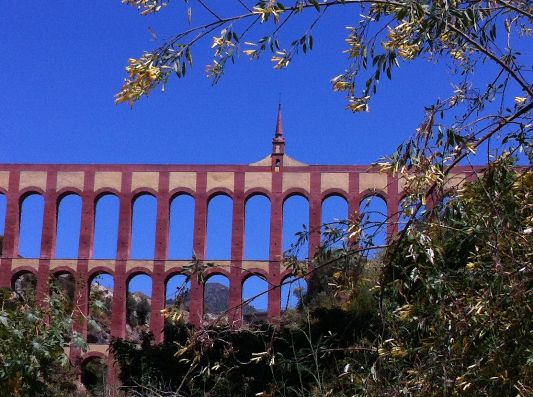 A mixture of quiet roads, tracks and footpaths led us along beside the jacaranda trees overlooking Nerja, down to the famous aqueduct, and down a farm track to the sea. After the peace of the countryside it was a shock to turn the final bend and see Burriana Beach lined with sunbeds, chiringuitos, and hordes of tourists. A mixture of quiet roads, tracks and footpaths led us along beside the jacaranda trees overlooking Nerja, down to the famous aqueduct, and down a farm track to the sea. After the peace of the countryside it was a shock to turn the final bend and see Burriana Beach lined with sunbeds, chiringuitos, and hordes of tourists.
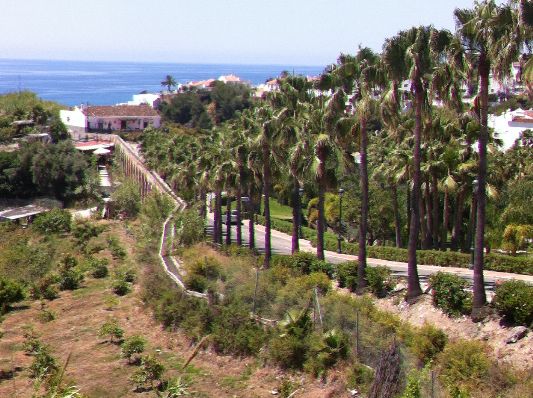 Although guiding walks is a job for John, it’s his joy as well so he was in no rush to finish our “half-day” walk. We stopped at Ayo’s chiringuito for paella, and chatting to the waiter we established that Ayo (short for Francisco – huh?) Although guiding walks is a job for John, it’s his joy as well so he was in no rush to finish our “half-day” walk. We stopped at Ayo’s chiringuito for paella, and chatting to the waiter we established that Ayo (short for Francisco – huh?) 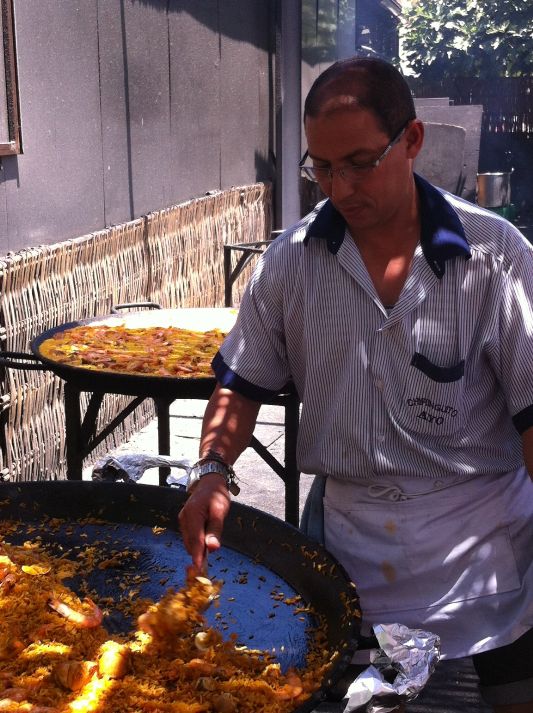 was a good friend of the five discoverers of the caves. We surmised that Ayo was holding the coats, or didn’t like the dark, or something. But even so, it felt like a connection to that exciting moment of the discovery. was a good friend of the five discoverers of the caves. We surmised that Ayo was holding the coats, or didn’t like the dark, or something. But even so, it felt like a connection to that exciting moment of the discovery.
After one of the best paellas I’ve ever had (with refills included), we wandered along the pretty beach, and climbed up to the town. I had considered turning this into a mini-break, and 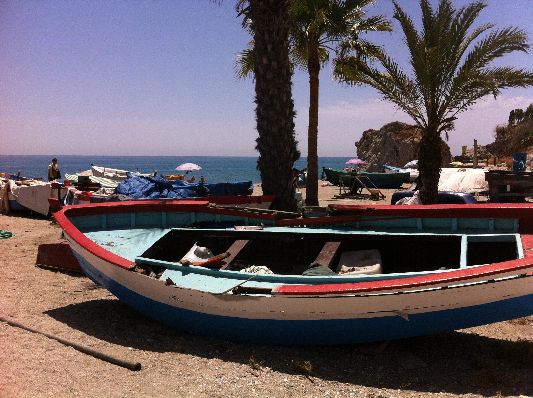 popped into a rather charming hotel we passed to see if theyhad a room for me. A rather brusque response that they were full surprised me, until I realised that I was apparently without luggage, asking for a single room, with four big chaps hovering just behind me! I think she MAY have thought I wanted the room by the hour! popped into a rather charming hotel we passed to see if theyhad a room for me. A rather brusque response that they were full surprised me, until I realised that I was apparently without luggage, asking for a single room, with four big chaps hovering just behind me! I think she MAY have thought I wanted the room by the hour!
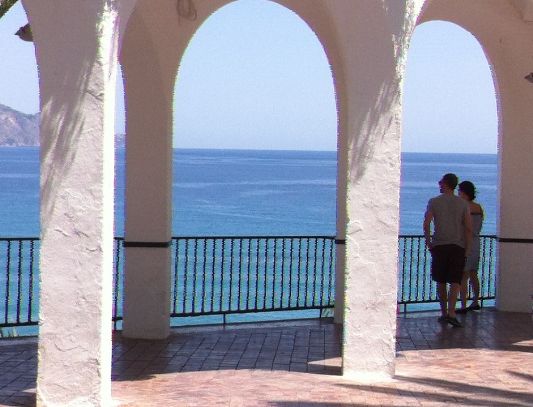 Our walk took us on to the main square and the picturesque Balcón de Europa where John finally left us. Apart from walking holidays, John has a great programme of day walks, and I look forward to doing more of these. Our walk took us on to the main square and the picturesque Balcón de Europa where John finally left us. Apart from walking holidays, John has a great programme of day walks, and I look forward to doing more of these.
My reputation in Nerja now in tatters, I gave up on the overnight idea and sloped off home – it was only an hour away after all.
© Tamara Essex 2013
THIS WEEK’S LANGUAGE POINT:
“Already” and “yet” give me grief, and Jose my intercambio partner has been drilling me on them. “Already” is not so hard – Ya se ha ido – he has already gone. Ya hemos empezado – we have already started. Ya he pedido – I have already asked, or I’ve already ordered (that’s particularly good in cafes, when a second waiter comes to ask what you want).
But “yet” …. that changes depending if it is positive or negative. Ya lo has limpiado? Have you cleaned it yet? Si, ya lo he limpiado. Yes, I have cleaned it already. No, no lo he limpiado aún. No, I haven’t cleaned it yet. Aún no lo he leido. I haven’t read it yet.
 0
Like
Published at 2:04 PM Comments (10)
0
Like
Published at 2:04 PM Comments (10)
60 - Let's Prop Jesus on a Ladder
Thursday, June 13, 2013
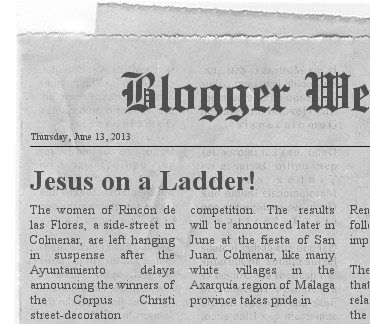 The arguing started before I was out of bed. Women’s voices, raised in conflict. “Más alta” … “No no - ¡¡¡ a la derecha !!!” …. “¡Arriba, arriba!” It sounded as though civil war was breaking out in my little street of seven houses. So much fighting? On a Sunday? The arguing started before I was out of bed. Women’s voices, raised in conflict. “Más alta” … “No no - ¡¡¡ a la derecha !!!” …. “¡Arriba, arriba!” It sounded as though civil war was breaking out in my little street of seven houses. So much fighting? On a Sunday?
Once breakfast is inside me I can delay it no longer, and venture out into the street. Las chicas from next door, Ana and Julia, leap on me and pull me towards the action. The big problem seems to be the need for more crocheted tablecloths to hang in the space between my side and the other side of the lane, to create a shaded area. I have a vague memory of seeing one in a drawer, left behind by the previous owners. I go and rifle through the big old Spanish-style dresser with curtained glass doors and drawers below. Yes! Triumphantly I dash outside waving my trophy, only to be met with disappointed glares. Mine is pale cream and no use at all. Jesus can only be shaded under WHITE crocheted tablecloths on Corpus Christi.
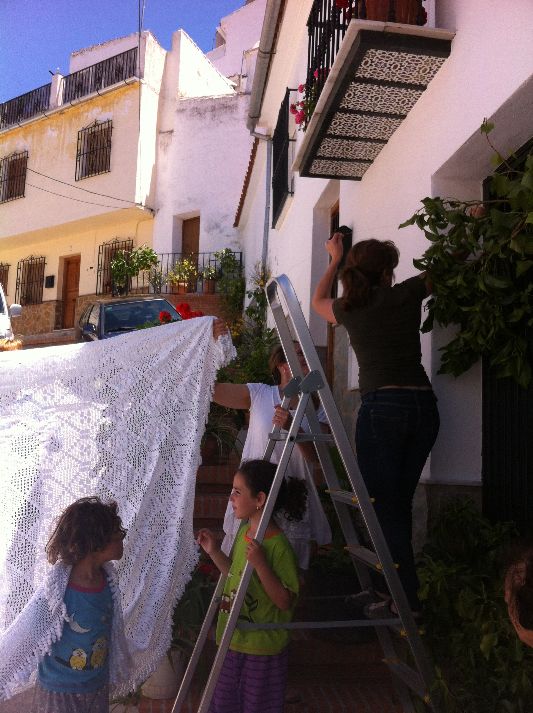 We make do with what we have. Ana-Marie is pointing at the metal above the garage doors, planning to tie the tablecloth to that. I think it’s too low. I start the argument all over again. I insist it needs to be tied to the two balconies opposite, and to the bars on my upstairs windows. There’s nowhere else my side but Isabel has already tied it to the garage doors opposite. We make do with what we have. Ana-Marie is pointing at the metal above the garage doors, planning to tie the tablecloth to that. I think it’s too low. I start the argument all over again. I insist it needs to be tied to the two balconies opposite, and to the bars on my upstairs windows. There’s nowhere else my side but Isabel has already tied it to the garage doors opposite. 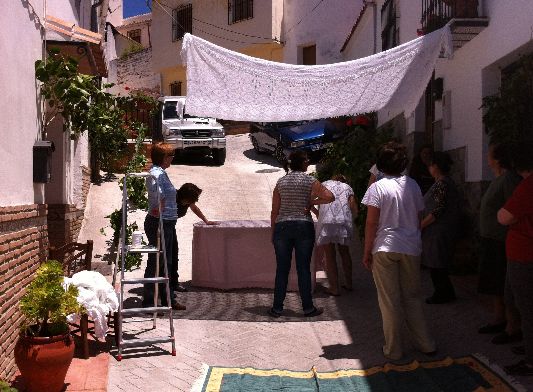 I loop the string around my window bars and gently pull it taut, tie it off, and return downstairs to view our work. It’s clearly too low on the other side. We all gaze at it. Julia says to the others “Tamara tiene razón”, Tamara is right. We untie all four corners and start again. I loop the string around my window bars and gently pull it taut, tie it off, and return downstairs to view our work. It’s clearly too low on the other side. We all gaze at it. Julia says to the others “Tamara tiene razón”, Tamara is right. We untie all four corners and start again.
At last the shade is sorted, the altar is in place. The heavy depiction of Jesus is brought carefully from Rafaella’s house, draped to protect it from the sun. She tries propping it in front of the table, but it doesn’t look right on the ground. She holds it 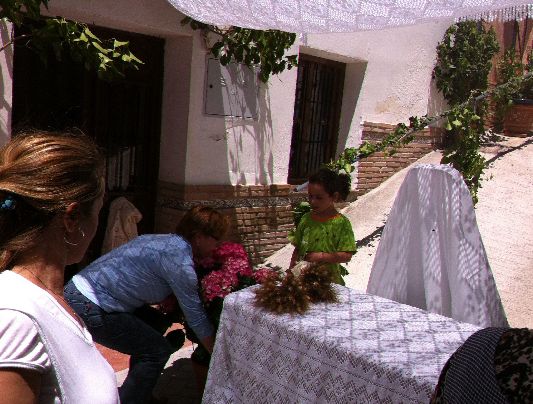 over the table. Perfect, but how will it remain in place? Tentatively, I suggest a small step-ladder. We can prop Jesus on a ladder behind the altar. With a couple of large stones to ensure it doesn’t shift, and yet another white sheet covering the ladder, it sort of works. Jesus is taken back indoors to Rafaella’s safe-keeping until nearer the time. over the table. Perfect, but how will it remain in place? Tentatively, I suggest a small step-ladder. We can prop Jesus on a ladder behind the altar. With a couple of large stones to ensure it doesn’t shift, and yet another white sheet covering the ladder, it sort of works. Jesus is taken back indoors to Rafaella’s safe-keeping until nearer the time.
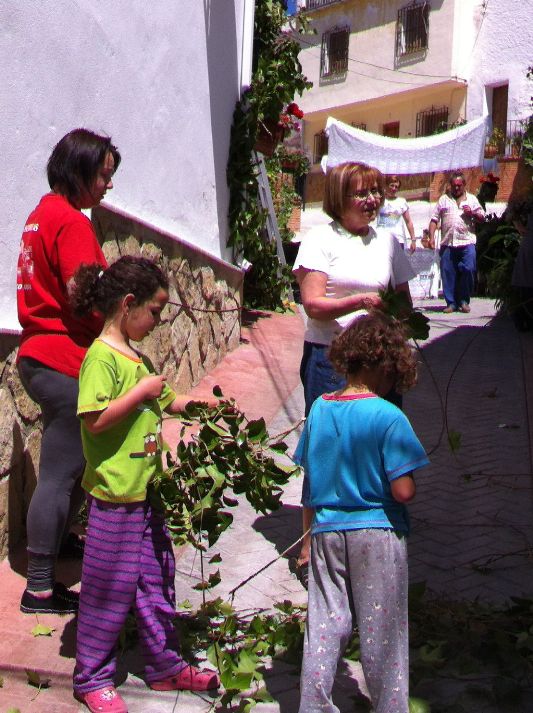 Finally, armfuls of branches of yedra are scattered along the pavements, petals are tipped in the centre and skilfully fashioned into a cross and a chalice. Someone turns up with a little waterfall. I plug it into my house so that it provides a trickling background to our display. A neighbour’s budgie-cage is plonked on my windowsill. Little Ana and Julia busy themselves adding petals to anything they see. Finally, armfuls of branches of yedra are scattered along the pavements, petals are tipped in the centre and skilfully fashioned into a cross and a chalice. Someone turns up with a little waterfall. I plug it into my house so that it provides a trickling background to our display. A neighbour’s budgie-cage is plonked on my windowsill. Little Ana and Julia busy themselves adding petals to anything they see.
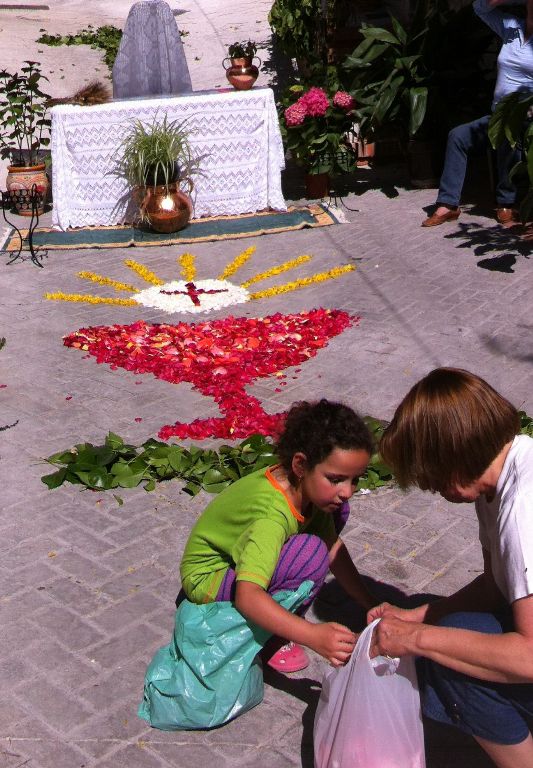 We collapse for coffee and cake in Isabel’s kitchen. She lives above her brother’s house, and hers is complicatedly intertwined with mine and his, as all three used to be one. From her top terrace, the first time I have been all the way up there, I can finally see exactly how the three houses are divided. We collapse for coffee and cake in Isabel’s kitchen. She lives above her brother’s house, and hers is complicatedly intertwined with mine and his, as all three used to be one. From her top terrace, the first time I have been all the way up there, I can finally see exactly how the three houses are divided.
Back outside, Jesus is brought out and propped on his ladder. Everybody’s cameras appear and the “Team Rincón de las Flores” photo is taken. 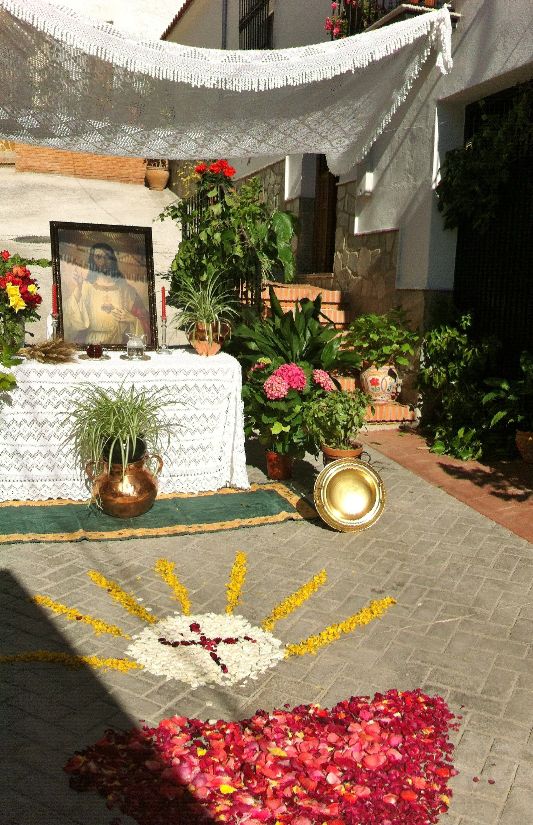 The first of the townsfolk arrive, on their pilgrimage around the altars. Then the judges appear. We hover nervously out of their way. They seem to miss the waterfall, so little Ana runs up to point it out to them. They make notes, mutter, take photos, and leave. The first of the townsfolk arrive, on their pilgrimage around the altars. Then the judges appear. We hover nervously out of their way. They seem to miss the waterfall, so little Ana runs up to point it out to them. They make notes, mutter, take photos, and leave.
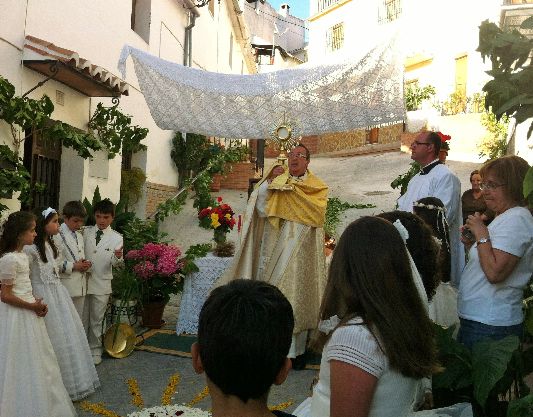 The communion children and the cura arrive and squeeze into our tiny street. The cura blesses our altar, and waves a general blessing around the street. A mini-mass is sung, rather beautifully. They leave, to continue on to the other Corpus Christi altars. My home has always felt blessed - and now, actually, it is. The communion children and the cura arrive and squeeze into our tiny street. The cura blesses our altar, and waves a general blessing around the street. A mini-mass is sung, rather beautifully. They leave, to continue on to the other Corpus Christi altars. My home has always felt blessed - and now, actually, it is.
“Equipo de Rincón” go for a walk to look at the competition. It’s impressive (though the photo I put on Facebook draws rude comments about one street hanging 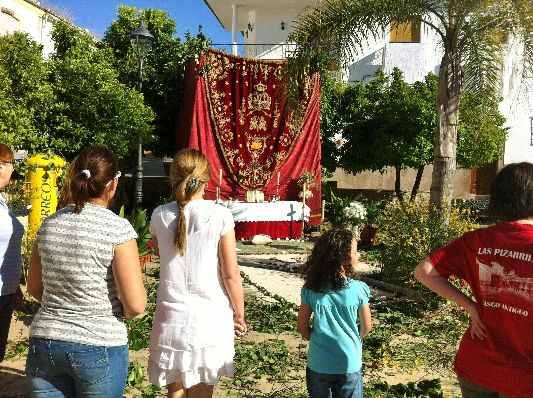 enormous brassiéres across the street). Damn, they’re good! All had more space than us. Some had natural features like trees, or the fountain in the plaza, others had large props such as big statues. The Cofradía de la Virgen Candelaria has a vast membership and significant resources. Our hopes for a prize diminish with each display we see. But we steal some ideas, particularly for creating a backdrop next year. enormous brassiéres across the street). Damn, they’re good! All had more space than us. Some had natural features like trees, or the fountain in the plaza, others had large props such as big statues. The Cofradía de la Virgen Candelaria has a vast membership and significant resources. Our hopes for a prize diminish with each display we see. But we steal some ideas, particularly for creating a backdrop next year.
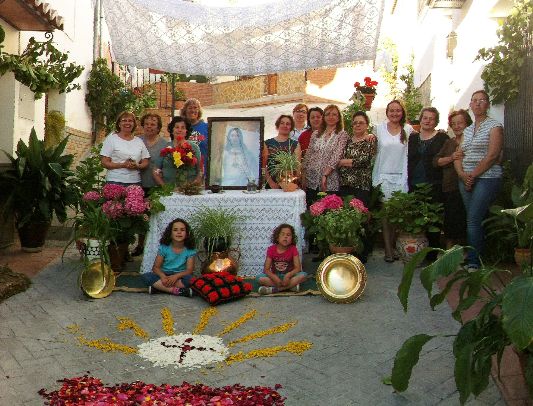 We will not find out till the Fiesta de San Juan at the end of the month whether we scraped into the prizes. But we’ve decided we don’t care. Isabel says there should be a special prize for the best team, the best collaboration between neighbours. In that category, we already know we are winners. We will not find out till the Fiesta de San Juan at the end of the month whether we scraped into the prizes. But we’ve decided we don’t care. Isabel says there should be a special prize for the best team, the best collaboration between neighbours. In that category, we already know we are winners.
© Tamara Essex 2013
THIS WEEK’S LANGUAGE POINT:
So many “false friends”! I get confused between sensible and sensitive – I’m a bit sensitive, or I’m a bit emotional, is “Estoy un poco sensible”. But if I DO want to say that I’m sensible, or rational, it’s “Soy una persona sensata.” The first is “estoy” because it’s a temporary state of being, whereas in the second it is a fundamental characteristic so it is “soy”.
And note the male/female endings here … even though I’m female it is still “un poco” in the first example, and in the second “sensata” remains the same for men because “una persona” is female, even if you’re not! Hope that makes sense J
 0
Like
Published at 10:37 PM Comments (3)
0
Like
Published at 10:37 PM Comments (3)
59 - Slow Food
Thursday, June 6, 2013
Even Francisco, the chef, described the taste of snails as “insípido” (I really DON’T have to translate that one into English, do I?).
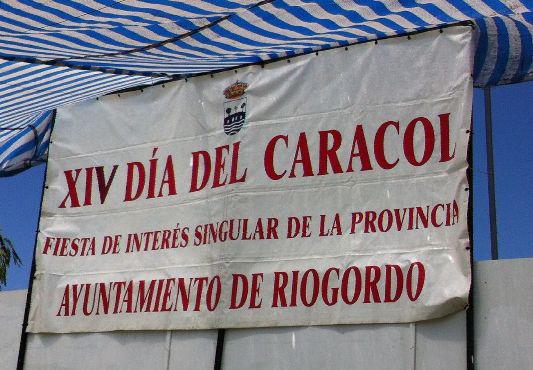 Caracoles, snails, really are the ultimate “slow food”. In every way. The preparation for Riogordo’s “Day of the Snail” began two days earlier when the snails were …. ummm … picked? Harvested? Whatever. They’re not special snails, and they’re not bred on ….. ummm …. snail farms. They are just random wild snails, taken from the campo and the sierra. Obviously there are areas where bigger, fatter ones can be found, so the ….. ummm …. snail-pluckers go out early to harvest the best ones. Caracoles, snails, really are the ultimate “slow food”. In every way. The preparation for Riogordo’s “Day of the Snail” began two days earlier when the snails were …. ummm … picked? Harvested? Whatever. They’re not special snails, and they’re not bred on ….. ummm …. snail farms. They are just random wild snails, taken from the campo and the sierra. Obviously there are areas where bigger, fatter ones can be found, so the ….. ummm …. snail-pluckers go out early to harvest the best ones.
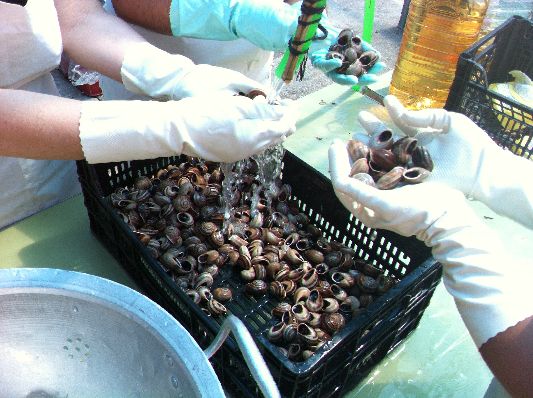
Still alive, they are washed. First in salt-water, then under a hose to remove any last bits of soil, sand, and of course the salt from the first wash.

Then into the huge pans over the big gas ring. The water starts cold and slowly warms up. This encourages the snails to come partly out of the shells, at which point the temperature is whacked up, to boil the water as quickly as possible which kills the snails.
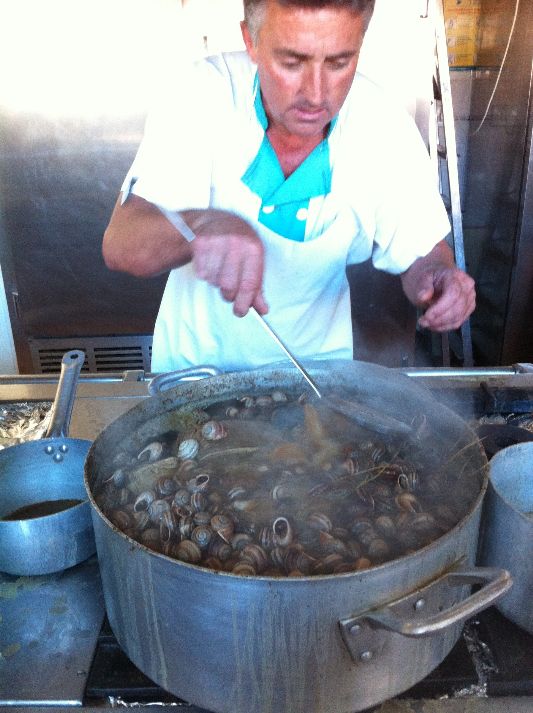
Then they go into the stock. “It’s the stock that gives them the flavour” explained Francisco. “Without it, they are insipid and tasteless.”
Elsewhere in Spain there are other Snail Festivals. The most famous is in Lleida in Catalunya, and each venue protects its own special recipe. I’d tried snails only once before, in a professional chef competition in Dorset, where they were cooked by a chef I trusted completely. He had picked armfuls of wild garlic flowers on the way to the competition, and served the snails in a thick, tasty, bright green puree. They were delicious. The traditional French recipes involve lashings of garlic, butter, white wine, and sometimes cream.
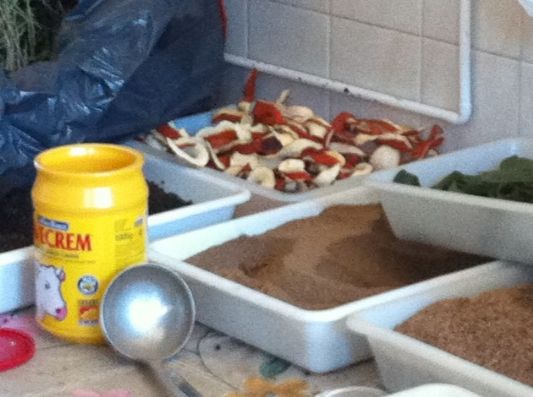 Here in Riogordo Francisco was happy to share his stock recipe. Dozens of muslin bags are made up – not dinky little bouquet garni like we’re used to; these were heavy great bags, stuffed with fresh sprigs of thyme, bay leaf, beef stock, dried orange peel, black peppercorns, chili and “snail spice mix”. The orange peel itself had taken a long time to prepare. It needed to be shaved very thinly, avoiding the pith as much as possible. Just the orange slivers of skin, laid out to dry, then added to the stock. Here in Riogordo Francisco was happy to share his stock recipe. Dozens of muslin bags are made up – not dinky little bouquet garni like we’re used to; these were heavy great bags, stuffed with fresh sprigs of thyme, bay leaf, beef stock, dried orange peel, black peppercorns, chili and “snail spice mix”. The orange peel itself had taken a long time to prepare. It needed to be shaved very thinly, avoiding the pith as much as possible. Just the orange slivers of skin, laid out to dry, then added to the stock.
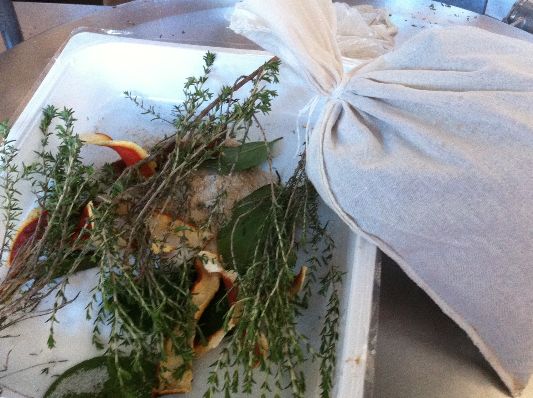 So the snails and the bags of stock go into fresh water which is boiled again, with an extra armful of thyme sprigs for good luck. It takes several hours of slow cooking to flavour the (otherwise insipid!) flesh. Once served, fresh mint is added at the last minute. So the snails and the bags of stock go into fresh water which is boiled again, with an extra armful of thyme sprigs for good luck. It takes several hours of slow cooking to flavour the (otherwise insipid!) flesh. Once served, fresh mint is added at the last minute.
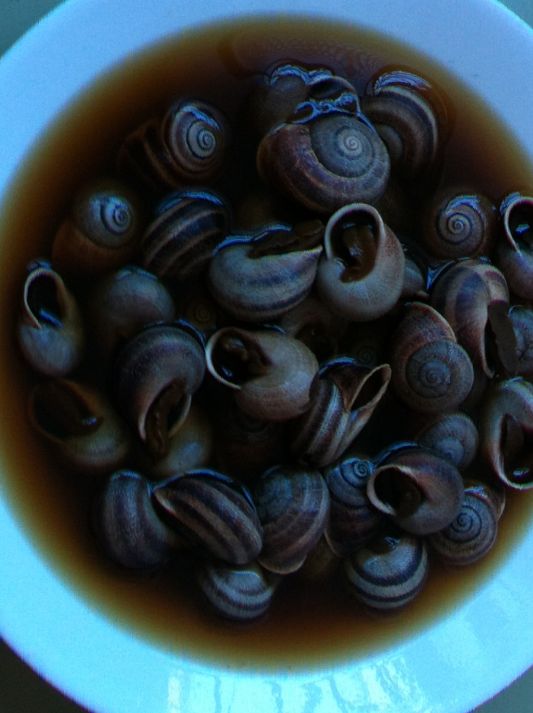
I had some. Well, it would have been rude not to. The stock HAD flavoured the snails, but personally I prefer either the French or the Dorset style. All this preparation was going on the day before the main festival in Riogordo, and Francisco assured me that 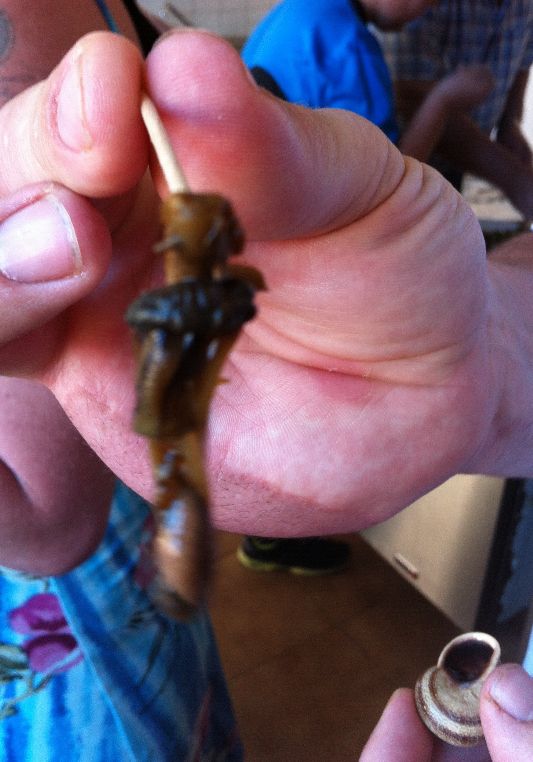 the following day the stock would have given the snails even more flavour. All the bars and restaurants would be selling snails, and there was an opportunity to taste them a dozen different ways. A “snail-crawl”, if you like (oh please yourselves!). the following day the stock would have given the snails even more flavour. All the bars and restaurants would be selling snails, and there was an opportunity to taste them a dozen different ways. A “snail-crawl”, if you like (oh please yourselves!).
On the Sunday of the festival, I was summonsed into my little street by the other women. We had work to do. It was the Corpus Christi street decoration competition and my presence was required to …. well …. climb ladders, decorate balconies, and …… and that’s another story. It was not going to be the Riogordo snail-crawl for me after all.
© Tamara Essex 2013
THIS WEEK’S LANGUAGE POINT:
Well, not so much a language learning point, more the answer to the question we’ve all been asking ourselves …. Just how is “Paco” any sort of short form of Francisco?
Well there IS logic behind this, after all! Saint Francis of Assisi was the father of the Franciscan order of monks. Within that order his name was written as Pater Comunitatis – father of the community. “Paco” comes from the first syllable of each word. Simples!
 0
Like
Published at 1:59 PM Comments (4)
0
Like
Published at 1:59 PM Comments (4)
Spam post or Abuse? Please let us know
|
|